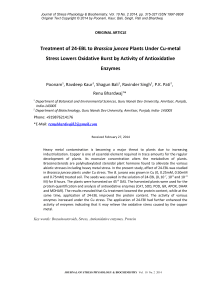Treatment of 24-EBL to Brassica juncea plants under cu-metal stress lowers oxidative burst by activity of antioxidative enzymes
Автор: Poonam , Kaur Ravdeep, Bali Shagun, Singh Ravinder, Pati P.K., Bhardwaj Renu
Журнал: Журнал стресс-физиологии и биохимии @jspb
Статья в выпуске: 2 т.10, 2014 года.
Бесплатный доступ
Heavy metal contamination is becoming a major threat to plants due to increasing industrialization. Copper is one of essential element required in trace amounts for the regular development of plants. Its excessive concentration alters the metabolism of plants. Brassinosteroids are polyhydoxylated steroidal plant hormone found to alleviate the various abiotic stresses including heavy metal stress. In the present study, effect of 24-EBL was studied in Brassica juncea plants under Cu stress. The B. juncea was grown in Cu (0, 0.25mM, 0.50mM and 0.75mM) treated soil. The seeds was soaked in the solution of 24-EBL (0, 10 -7, 10 -9 and 10 -11 M) for 8 hours. The plants were harvested on 45 th DAS. The harvested plants were used for the protein quantification and analysis of antioxidative enzymes (CAT, SOD, POD, GR, APOX, DHAR and MDHAR). The results revealed that Cu treatment lowered the protein content, while at the same time, application of 24-EBL improved the protein content. The activity of various enzymes increased under the Cu stress. The application of 24-EBl had further enhanced the activity of enzymes indicating that it may relieve the oxidative stress caused by the copper metal.
Brassinosteroids, stress, antioxidative enzymes, protein
Короткий адрес: https://sciup.org/14323871
IDR: 14323871
Текст научной статьи Treatment of 24-EBL to Brassica juncea plants under cu-metal stress lowers oxidative burst by activity of antioxidative enzymes
Increasing levels of heavy metals in soil, water and air, are becoming one of the major environmental problems posed to the present world. Even in trace concentrations, they pose serious problem to the entire organisms. Among various heavy metals, copper (Cu) comes in essential micronutrient required for the plant growth and metabolism. This metal is required in various biochemical processes as these are part of many enzymes and proteins. Cu is present as a cofactor of various enzymes such as plastocyanin, cytochrome c, and Cu/Zn superoxide dismutase. But the excess amounts of Cu adversely affect the plant growth and metabolism. As Cu is a redox active metal, it catalyzes the production of reactive oxygen species (ROS) like superoxide, hydrogen peroxide and hydroxyl radicals (Aust et al., 1985). ROS formation lead to oxidative stress and it damages the essential cellular components like DNA, proteins and lipids, further it affects the plant growth and alters the antioxidant system (Song-Hua et al., 2004). Plants have evolved antioxidant mechanisms to combat the oxidative stress induced by heavy metal stress. These include numerous ROS-scavenging enzymes for example superoxide dismutase (SOD), catalase (CAT), guaiacol peroxidase (POD), ascorbate peroxidase (APOX), glutathione reductase (GR), Monodehydroascorbate reductase (MDHAR) and dehydroascorbate reductase (DHAR). There are reports available which suggest the Cu-induced antioxidative defence in the roots of Brassica juncea and in Arabidopsis (Baker, 1987).
Brassinosteroids (BRs) are group of steroidal plant hormones, structurally similar to animal and insect steroid hormones. Clouse and Sasse, 1998 suggested that BRs play essential roles in broad spectrum of developmental and physiological processes such as cell elongation and cell division, photomorphogenesis, xylem differentiation, seed germination and fruit ripening. Various studies point out that BRs have ability to enhance the capacity of plants to cope with various stresses like heavy metal stress, water stress, salt stress etc. (Ali et al., 2008; Bajguz and Hayat, 2009).
The present study is designed with the objective to find the ability of 24-Epibrassinolide (EBL) to enhance the antioxidative defence system on Brassica juncea plants under Cu stress.
MATERIALS AND METHODS
On the 45th DAS, the plants were harvested from the pots very carefully. Roots and shoots of the plants were separated. For antioxidative enzyme analysis, leaves were harvested and frozen at -20o C temperature till further analysis.
Preparation of plant extract: The plant extract was prepared by homogenizing 1g of plant sample in 3 ml of chilled 50 mM potassium phosphate buffer (pH 7.0) in a pre-chilled mortar and pestle. For estimation of superoxide dismutase enzyme, the extraction was done using sodium carbonate buffer. This obtained homogenate was centrifuged at 12000×g for 20 minutes at 4o C. The supernatant was used for the estimation of proteins and various antioxidative enzymes.
Protein Quantification: Total protein content of different samples of Cu (0, 0.25, 0.5 and 0.75 mM) and 24-EBL (0, 10-7, 10-9 and 10-11 M) alone and in combination was determined using Lowery (1951). The bovine serum albumin was used as standard.
Catalase assay: Catalase (CAT, EC 1.11.1.6) activity was measured using the method of Aebi (1984). The decrease in H 2 O 2 was followed as decrease in absorbance at 240nm for 1 minute at 25oC. The reaction mixture (3.0 ml) contains potassium phosphate buffer (50mM, pH 7.0), 15 mM H 2 O 2 and 100 µl enzyme extract. The extinction coefficient 39.48 mM-1cm-1 was used for the calculations.
Superoxide dismutase: Superoxide dismutase (SOD, EC 1.15.1.1) activity was measured spectrophotometrically using the method of Kono (1978) in which ability of enzyme extract was measured to inhibit the photochemical reduction of nitroblue tetrazolium (NBT). The reaction mixture (3.0 ml) contained 50mM sodium carbonate buffer
(pH 10.2), 24µM NBT, 0.1 mM EDTA, 1mM hydroxylamine, 0.03% (v/v) triton X-100 and 70 µl enzyme extract. The absorbance at 560 nm for 2 minutes was recorded.
Ascorbate peroxidase assay: The activity of ascorbate peroxidise (APOX, EC 1.11.1.11) was determined by using spectrophotometer following the method of Nakano and Asada (1981). The reaction mixture (3.0 ml) contained 50 mM potassium phosphate buffer (pH 7.0), 0.5 mM ascorbate, 1.0 mM H 2 O 2 and 100 µl enzyme extract. The oxidation of ascorbate which depends on H 2 O 2 was followed by monitoring the decrease in absorbance at 290 nm with extinction coefficient 2.8mM-1cm-1.
Guaiacol peroxidase: Guaiacol peroxidase (POD, EC 1.11.1.7) activity was measured using the method of Sànchez et al. (1995). The reaction mixture of 3.0 ml contained 50 mM potassium phosphate buffer (pH 7.0), 20 mM guiacol, 12.3 mM H 2 O 2 and and 100 µl enzyme extract. The POD activity was assayed by measuring the absorbance at 436 nm and 26.6 mM-1cm-was used as extinction coefficient.
Glutathione reductase assay: Glutathione reductase (GR, EC 1.6.4.2) activity was assayed by following the method of Carlberg and Mannervik (1975). The reaction mixture of 3.0 ml contained 50 mM potassium phosphate buffer (pH 7.6), 1 mM GSSG, 0.5 mM EDTA, 0.1 mM NADPH and 100 µl enzyme extract. The reaction started with the addition of NADPH and oxidation of NADPH was followed and noted at 340 nm with extinction coefficient of 6.22 mM-1cm-1.
Dehydroascorbate reductase: Dehydroascorbate reductase (DHAR, EC 1.8.5.1) activity was estimated following the method of
Dalton et al. (1986). The reaction mixture (3.0 ml) contained 50 mM potassium phosphate buffer (pH 7.0), 1mM EDTA, 15 mM reduced glutathione and 2 mM dehydroascorbate. The enzyme activity was measured by following the increase in absorbance at 265 nm due to ascorbate formation.
Monodehydroascorbate reductase: Monodehydroascorbate reductase (MDHAR, EC 1.1.5.4) activity was estimated using the method of Hossain et al. (1984). The reaction mixture (3.0 ml) contained 50 mM potassium phosphate buffer (pH 7.5), 0.1 mM EDTA, 0.25% (v/v) triton X-100, 30 mM ascorbate, 3 mM NADH and 0.25 units ascorbate oxidase. The enzyme activity was measured by following the decrease in absorbance due to the oxidation of NADH at 340 nm.
RESULTS
The observations on Cu stressed shoots revealed that protein content decreased with increasing concentration of metal and at the highest concentration of metal that is 0.75mM, the protein content was observed lowest (7.97±0.46 mg g-1 FW) as compared to control (13.285 ± 0.59 mg g-1 FW) (Fig-1). The application of 24-EBL has increased the protein content in Brassica plants. The treatment of shoots with the 24-EBL with Cu supplementation was higher in the concentration 0.25mM (14.39±0.65 mg g-1 FW) when compared to the treatment of 0.25mM Cu alone (11.36±0.11 mg g-1 FW). Catalase activity was increased with the increase in Cu concentration as compared to control (Fig-2). It was observed highest in 0.75mM Cu treated plants (16.78±0.94 mol UA mg protein-1) as compared to control (16.07±1.33 mol UA mg protein-1). It was maximum in shoots treated with 10-9 M 24-EBL supplemented with 0.5mM Cu solution (20.70±0.67 mol UA mg protein-1) when compared to control 0.25mM Cu treated shoots (16.32 ±1.05 mol UA mg protein-1). Similarly SOD activity (Fig-3) increased significantly under 0.25mM (5.03±0.31 mol UA mg protein-1), 0.5mM (5.39±0.0.27 mol UA mg protein-1) and 0.75 mM (5.09±0.05 mol UA mg protein-1) Cu metal concentrations in Brassica shoots as compared to untreated control (4.69±0.34 mol UA mg protein-1). 24-EBL alone was also able to increase the SOD activity. SOD activity was enhanced by Cu-metal supplemented with 24-EBL treatment. The activity was recorded to be maximum in case of Brassica shoots treated with Cu 0.75 mM supplemented 10 -7 M (6.22±0.31 mol UA mg protein-1) when compared to only 0.75 mM Cu treatment (5.09±0.05 mol UA mg protein-1). Similarly, APOX activity has observed to increase with the increasing concentration of Cu metal in Brassica shoots (Fig-4). The 0.75 mM Cu has been observed to have maximum enzyme activity (6.31±0.28 mol UA mg protein-1) when compared to control (4.62±0.18 mol UA mg protein-1). The application of 24-EBL had further enhanced the activity of APOX where maximum activity was observed in the 0.75mM Cu treated plants supplemented with 10-7 M 24-EBL. POD activity was increased with Cu treatment. The 24-EBL treatment has showed significant effect on this parameter in combination to metal concentration (Fig-5). Similarly, GR activity was increased under Cu stress (Fig-6) and it was found to increase significantly by application of different concentration of 24-EBL under Cu stress. Maximum concentration was recorded in the 0.75 mM (11.28±0.34 mol UA mg protein-1) when compared to the control (6.89±0.29 mol UA mg protein-1).
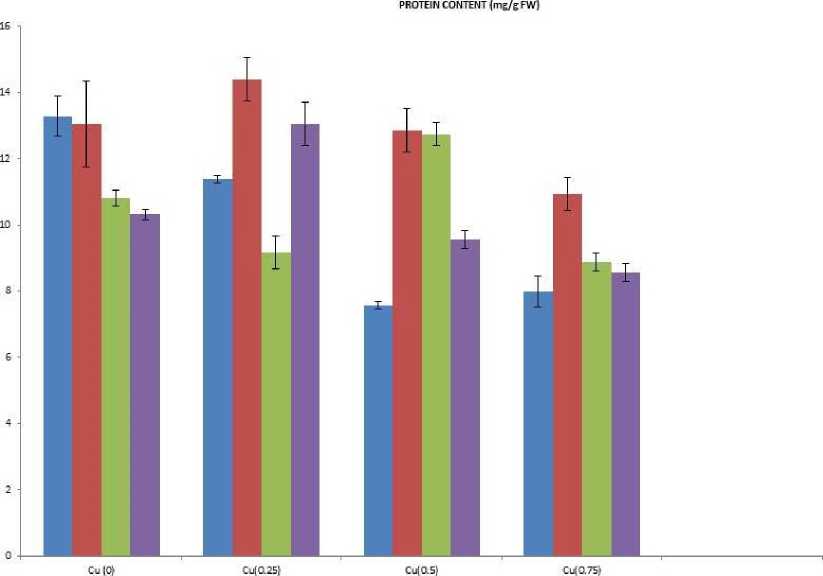
Figure 1. Effect of 24-EBL on Protein content of 45 days old plants of Brassica juncea under copper stress Treatment (Cu): F-Ratio (3x47) = 25.768 (Significant at p≤ 0.05); Dose (24-EBL): F-Ratio (3x47) = 23.204 (Significant at p≤ 0.05); Cu x 24-EBL: F-Ratio (9x47) = 10.89255835 (Significant at p≤ 0.05)
CATALASE (mol UA/mg protien)
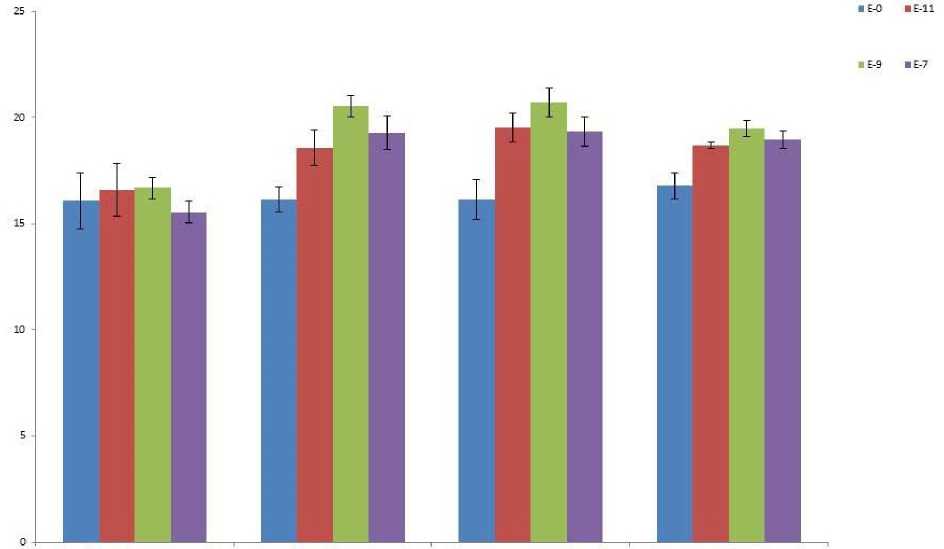
Cu (0) 040.25) 040.5) Cu(Q75)
Figure 2. Effect of 24-EBL on Catalase activity of 45 days old plants of Brassica juncea under copper stress
Treatment (Cu): F-Ratio (3x47) = 9.3066 (Significant at p ≤ 0.05); Dose (24-EBL): F-Ratio (3x47) = 12.73216836
(Significant at p ≤ 0.05); Cu x 24-EBL: F-Ratio (9x47) = 1.218513328 (Significant at p ≤ 0.05)
SOD (mol UA/mg protien)
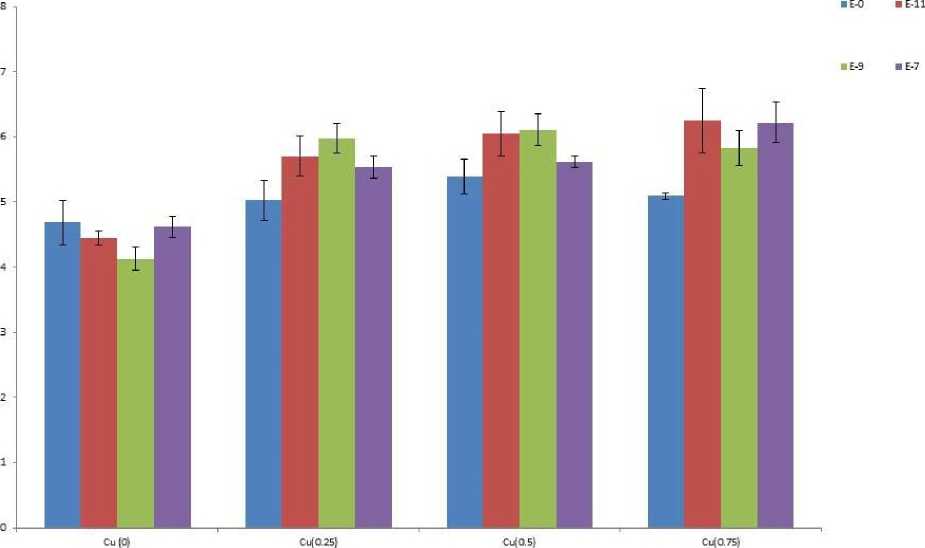
Figure 3. Effect of 24-EBL on SOD activity of 45 days old plants of Brassica juncea under copper stress
Treatment (Cu): F-Ratio (3x47) = 21.881 (Significant at p ≤ 0.05); Dose (24-EBL): F-Ratio (3x47) = 3.455 (Significant at p ≤ 0.05); Cu x 24-EBL: F-Ratio (9x47) = 1.546 (Significant at p ≤ 0.05)
A POX (mol UA/mg protien)

Cu(O CutQ25) CutO.5) CufO.75)
Figure 4. Effect of 24-EBL on APOX activity of 45 days old plants of Brassica juncea under copper stress Treatment (Cu): F-Ratio (3x47) = 39.42397639 (Significant at p ≤ 0.05); Dose (24-EBL): F-Ratio (3x47) = 5.894432658 (Significant at p ≤ 0.05); Cu x 24-EBL: F-Ratio (9x47) = 0.818055454 (Non- Significant at p ≤ 0.05)
POD (mol UA/mg protien)
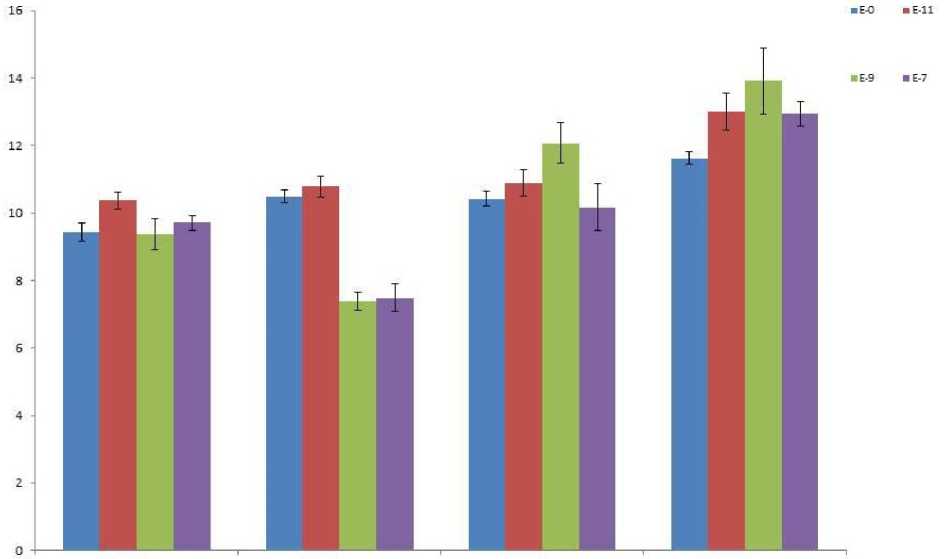
Cu (0) Cu(0.25) Cu(0.5) Cu(0.75)
Figure 5. Effect of 24-EBL on POD activity of 45 days old plants of Brassica juncea under copper stress Treatment (Cu): F-Ratio (3x47) = 54.47912861 (Significant at p ≤ 0.05); Dose (24-EBL): F-Ratio (3x47) = 4.659566276 (Significant at p ≤ 0.05); Cu x 24-EBL: F-Ratio (9x47) = 6.88511634 (Significant at p ≤ 0.05)
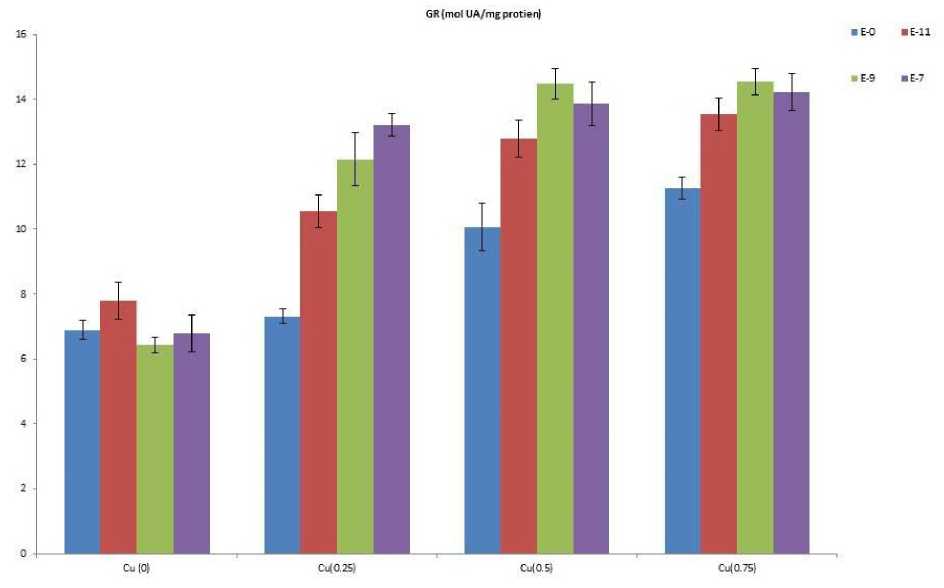
Figure 6. Effect of 24-EBL on GR activity of 45 days old plants of Brassica juncea under copper stress Treatment (Cu): F-Ratio (3x47) = 123.7078954 (Significant at p ≤ 0.05); Dose (24-EBL): F-Ratio (3x47) = 30.68424926 (Significant at p ≤ 0.05); Cu x 24-EBL: F-Ratio (9x47) = 5.069628786 (Significant at p ≤ 0.05)
DHAR (mol UA/mg protie n|
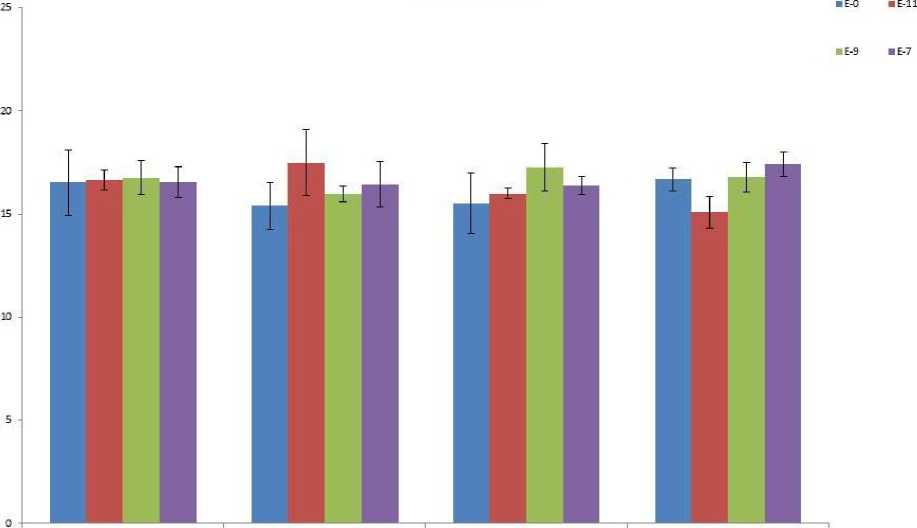
Си |0( Cu(O.25> CutO.5) CufQTS)
Figure 7. Effect of 24-EBL on DHAR activity of 45 days old plants of Brassica juncea under copper stress Treatment (Cu): F-Ratio (3x47) = 0.125259754 (Non-Significant at p ≤ 0.05); Dose (24-EBL): F-Ratio (3x47) = 0.515226351 NonSignificant at p ≤ 0.05); Cu x 24-EBL: F-Ratio (9x47) = 0.740487086 (Non-Significant at p ≤ 0.05)
MDHAR (mol UA/mg protien)
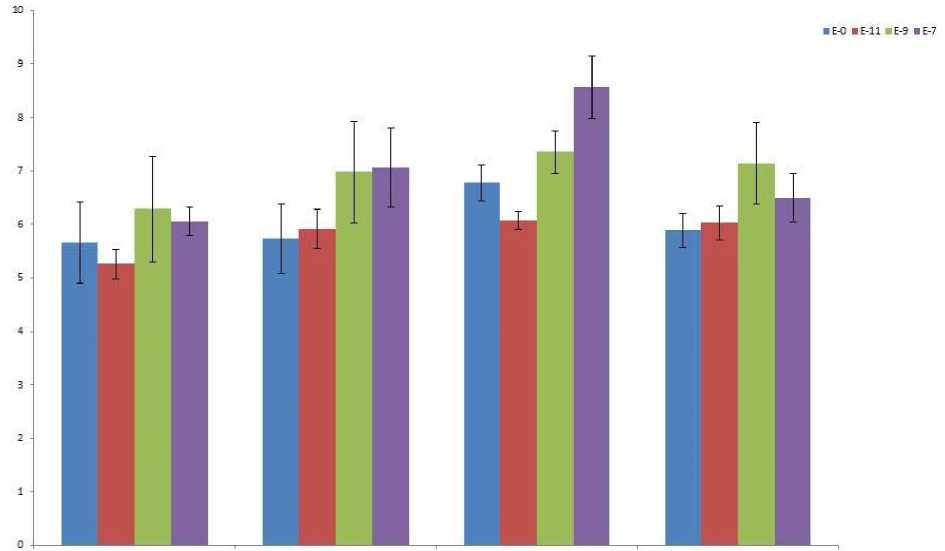
Cu |0) Cu(Q25) Cu«X5) Cu(a75)
Figure 8. Effect of 24-EBL on MDHAR activity of 45 days old plants of Brassica juncea under copper stress Treatment (Cu): F-Ratio (3x47) = 3.72172588 (Significant at p ≤ 0.05); Dose (24-EBL): F-Ratio (3x47) = 5.192876399 (Significant at p ≤ 0.05); Cu x 24-EBL: F-Ratio (9x47) = 0.580927367 (Non-Significant at p ≤ 0.05)
The supplementation of 24-EBL with Cu has also increased the GR activity where the maximum activity was recorded in the 0.75mM Cu supplemented with the 10-9 M EBL (14.21±0.57 mol UA mg protein-1) in comparison to the control (11.28±0.34 mol UA mg protein-1). DHAR activity was increased with the increasing concentration of Cu (Fig-7). It was highest in 0.75 mM Cu treated Brassica shoots (16.68±0.55 mol UA mg protein-1) as compared to control (16.53±1.6 mol UA mg protein-1). DHAR activity was further enhanced by the application of different concentrations of 24-EBL under Cu stress but this increase was not significant. Its maximum activity was observed in the 0.25 mM Cu solution supplemented with 10-11 M EBL (17.48±1.6 mol UA mg protein-1).
The activity of MDHAR was increased with the increasing concentration of Cu metal (Fig-8), while 0.5mM Cu metal treatment showed the maximum activity (6.78±0.33 mol UA mg protein-1) as compared to the control (5.66±0.76 mol UA mg protein-1). The application of 24-EBL has significantly increased the MDHAR activity. The maximum activity was recorded at 0.5mM Cu when supplemented with the 10-9 M EBL.
DISCUSSION
It is well established fact that, heavy metal phytotoxic expression include production of reactive oxygen species (ROS), ionic transport imbalance, inhibition of antioxidative enzymes and protein degradation (Aravind et al., 2009; Ann et al., 2011; Gangwar et al ., 2012). Under heavy metal stress, reduction of molecular oxygen occurs. Various intermediates such as superoxide radicals (O 2 ), hydroxyl radicals (OH-) and hydrogen peroxide (H 2 O 2 ) which are more toxic and reactive than oxygen. These active molecules participate in free radical chain reactions of membrane lipids and proteins thus cause oxidative decomposition
(Kanoun-Boule et al., 2009; Ann et al ., 2011). These ROS are hazardous molecules for cell but it has been discovered that ROS also play an important role in plant defence against oxidative burst (Schützendübel and Polle 2002). Because of toxic nature of ROS their level must be regulated in the cells. This controlling system comprise of antioxidants including enzymes such as SOD, POD, CAT, GR, APOX, GPX, DHAR and MDHAR and non-enzymatic antioxidants such as ascorbic acid, glutathione content and tocopherol to suppress the ROS (Mittler 2002; Munne-Bosch 2005; Kanoun-Boulé et al., 2009; Maleva et al ., 2009; Kumar et al ., 2012). To suppress the effect of metal toxicity, production of antioxidative enzymes and antioxidants increases in the plants (Alscher et al ., 2002). As the ROS directly harm the membrane proteins, the decrease in the protein content was observed with increasing metal concentrations (Fig-1). This decrease in the protein content might be possibly due to decrease in the metabolism of amino acids (El-Shintinawy and El-Ansari 2000). While the 24-EBL favors plant basic processes and thus found to increase the protein content as obtained in our results (Fig-1). This increase can be explained on the basis of well documented effect of BRs on translation and transcription (Mandava 1988; Bajguz 2002; Fariduddin et al ., 2004) Similarly increase in the protein content was observed by the exogenous application of EBL under various metal stress (Ahammad et al., 2013; Alam et al ., 2007).
Antioxidative enzymes like SOD, POD, CAT and APOX are important enzymes involved in the detoxification of ROS. SOD belongs to the metallozymes family which catalyzes the superoxide radicals to O2 and H2O2. CAT further remove the H2O2 in the peroxisomes or H2O2 is removed by membrane enzyme POD or by APOX in the chloroplast (Foyer et al., 1997). GR belongs to the flavoenzymes which reduces the glutathione disulphide (GSSG) which is NADPH dependent into glutathione (GSH) and maintain the reduced form of glutathione, which in turn reduces dehydroascorbate to ascorbate (Noctor and Foyer 1998). Because the reduced form of ascorbic acid is necessary for ROS scavenging and DHAR and MDAHR help in maintain its cellular pool using NADPH as reducing power. Our results indicated that treatment of Brassica juncea plants with 24-EBL has effectively encouraged the activity of these enzymes in plants. Various findings have reported that BRs can persuade the expression of some antioxidant genes and also enhances the activity of antioxidant enzymes like SOD, CAT, APOX and POD (Mazorra et al., 2002; Cao et al., 2005). The enhanced level of GR activity might reduce GSSG to GSH and supply more GSH to increase the detoxification process (Ahammad et al., 2012). Increase in GR activity was recorded in our results under Cu stress. Moreover the supplementation of 24-EBL has further enhanced the level of GR in shoots. These results are favoured by various reports which suggest that EBL treatment improve xenobiotic metabolism by enhancing the activities of POD and GR (Xia et al., 2009; Ahammad et al., 2012). Enhanced activity of GR increases tolerance to oxidative stress (Nocter and Foyer 1998). Behnamnia et al., (2009) has also found that treatment of EBL in drought stressed tomato plants increases the expression of antioxidative enzymes such as POD, SOD, CAT and GR. Sharma et al., (2011) has reported the increase in the DHAR and MDHAR activity in Raphanus plants under chromium stress where exogenous application of 28-HBL was used. Enhanced activities of DHAR and MDHAR were recorded in our observations also.
CONCLUSION
To conclude with, treatment of 24-EBL to B. juncea plants under Cu metal stress is involved in amelioration of toxic effects to plants with special reference to activity of antioxidative enzymes.
ACKNOWLEDGEMENT
We gratefully acknowledge the Council of Scientific and Industrial Research, New Delhi, India for the financial assistance.
Список литературы Treatment of 24-EBL to Brassica juncea plants under cu-metal stress lowers oxidative burst by activity of antioxidative enzymes
- Aebi, H. (1984). Catalase in Vitro. Methods Enzymol., 105, 121-126
- Ahammed, G.J., Choudhary, S.P., Chen, S., Xia, X., Shi, K., Zhou, Y., and Yu, J. (2013). Role of brassinosteroids in alleviation of phenanthrene-cadmium co-contamination-induced photosynthetic inhibition and oxidative stress in tomato. J. Exp. Bot., 64, 199-213
- Alam, M.M., Hayat, S., Ali, B., and Ahmad, A. (2007). Effect of 28-homobrassinolide on nickel induced changes in Brassica juncea. Photosynthetica, 45, 139-142
- Ali, B., Hayat, S., Fariduddin, Q., Ahmad, A. (2008). 24-Epibrassinolide protects against the stress generated by salinity and nickel in Brassica juncea. Chemosphere, 72, 1387-1392
- Alscher, R.G., Erturk, N., and Heath, L.S. (2002). Role of superoxide dismutases (SODs) in controlling oxidative stress in plants. J. Exp. Biol., 53, 1331-1341
- Ann, C., Karen, S., Jos, R., Kelly, O., Els, K., Tony, R., Nele, H., Nathalie, V., Suzy, V.S., Frank, V.B., Yves, G., Jan, C., and Jaco, V. (2011). The cellular redox state as a modulator in cadmium and copper responses in Arabidopsis thaliana seedlings. J. Plant. Physiol., 168, 309-316
- Aravind, P., Prasad, M.N.V., Malec, P., Waloszek, A., Strzałka, K., (2009). Zinc protects Ceratophyllum demersum L. (free-floating hydrophyte) against reactive oxygen species induced by cadmium. J. Trace Elem. Med. Biol., 23, 50-60
- Aust, S.D., Marehouse, L.A., and Thomas, C.E. (1985). Role of metals in oxygen radical Reactions. J. Free Radic. Biol. Med., 1, 3-25
- Bajguz, A. and Hayat, S. (2009). Effects of brassinosteroids on the plant responses to environmental stresses. Plant Physiol. Biochem., 47, 1-8
- Bajguz, A., (2002). Brassinosteroids and lead as stimulators of phytochelatins synthesis in Chlorella vulgaris. J. Plant Physiol., 159, 321-324
- Baker, A.J.M. (1987). Metal tolerance. New Phytol., 106, 93-111
- Behnamnia, M., Kalantari, Kh.M., and Rezanejad, F. (2009). Exogenous application of brassinosteroid alleviates drought-induced oxidative stress in Lycopersicon esculentum L. General and Applied Plant Physiology, 35, 22-34
- Cao, S., Xu Q., Cao Y., QiAn K., An K., Zhu Y., Binzeng H., Zhao H., and Kuai B. (2005). Loss of function mutations in DET2 gene lead to an enhanced resistance to oxidative stress in Arabidopsis. Physiol. Plant., 123, 57-66
- Carlberg, I., and Mannervik, B. (1975). Purification and characterization of the flavoenzyme glutathione reductase from rat liver. J. Biol. Chem. 250, 5475-5480
- Clouse, S.D, and Sasse, J.M. (1998). Brassinosteroids: essential regulators of plant growth and development. Annu. Rev. Plant Physiol. Mol. Biol., 49, 427-451
- Dalton, D.A., Russell, S.A., Hanus, F.J., Pascoe, G.A., and Evans, H.J. (1986). Enzymatic reactions of ascorbate and glutathione that prevent peroxide damage in soybean root nodules. Proc. Natl. Acad. Sci. U.S.A., 83, 3811-3815
- El-Shintinawy, F., and El-Ansary, A. (2000). Differential effect of Cd2+ and Ni2+ on amino acid metabolism in soybean seedlings. Biol. Plantarum., 43, 79-84
- Fariduddin, Q. Ahmad, A. and Hayat, S. (2004). Response of Vigna radiata to foliar application of 28-homobrassinolide and kinetin. Biol. Plantarum, 48: 465-468
- Foyer, C.H., Lopez-Delgado, H., Dat, J.F., and Scott, I.M. (1997). Hydrogen peroxide-and glutathione-associated mechanisms of acclimatory stress tolerance and signalling. Physiol. Plant, 100, 241-254
- Gangwar, S., Singh, V.P., Srivastava, P.K., and Maurya, J.N. (2011). Modification of chromium (VI) phytotoxicity by exogenous gibberellicacid application in Pisum sativum (L.) seedlings. Acta. Physiol. Plant., 33, 1385-1397
- Hossain, M.A., Nakano, Y., and Asada, K. (1984). Monodehydroascorbate reductase in spinach chloroplasts and its participation in the regeneration of ascorbate for scavenging Hydrogen Peroxide. Plant Cell. Physiol., 25, 385-395
- Kanoun-Boule´, M., Vicente, J.A.F., Nabais, C., Prasad, M.N.V., and Freitas, H. (2009). Ecophysiological tolerance of duckweeds exposed to copper. Aquat. Toxicol., 91,1-9
- Kono, Y. (1978). Generation of superoxide radical during autooxidation of hydroxylamine and an assay for superoxide dismutase. Arch. Biochem. Biophys., 186, 189-195
- Kumar, A., Prasad, M.N.V., and Sytar, O. (2012). Lead toxicity, defense strategies and associated indicative biomarkers in Talinum triangulare grown hydroponically. Chemosphere, 89, 1056-1165
- Lowry, O.H., Resebrough, N.J., Farr, A.L., and Randall, R.J. (1951). Protein determination with folin reagent. J. Biol. Chem., 193, 265-275
- Maleva, M.G., Nekrasova, G.F., Malec, P., Prasad, M.N.V., and Strzałka, K. (2009). Ecophysiological tolerance of Elodea canadensis to nickel exposure. Chemosphere, 77, 393-398
- Mandava, B.N. (1988). Plant growth promoting brassinosteroids. Annu. Rev. Plant Physiol. Plant Mol. Biol., 39, 23-52
- Mazorro, L.M., Nunez M., Echeraria E., Coll F., and Sanchez-Blanco M.J. (2002). Influence of brassinosteroids and antioxidant enzymes activity in tomato under different temperatures. Biol. Plantarum, 45, 593-596
- Mittler, R. (2002). Oxidative stress, antioxidants, and stress tolerance. Trends Plant Sci., 7, 405-410
- Munné-Bosch, S. (2005). The role of alpha-tocopherol in plant stress tolerance. J. Plant Physiol., 162, 743-748
- Nakano, Y., and Asada, K. (1981). Hydrogen peroxide is scavenged by ascorbate specific peroxidase in spinach chloroplasts. Plant Cell Physiol., 22, 867-880
- Noctor, G., and Foyer, C.H. (1998). Ascorbate and glutathione: keeping active oxygen under control. Annu. Rev. Plant Physiol. Plant Mol. Biol., 49, 249-279
- Sánchez, M., Revilla, G. and Zarra, I. (1995). Changes in peroxidase activity associated with cell walls during pine hypocotyl growth. Ann. Bot., 75, 415-419
- Schu¨tzendu¨bel, A., and Polle, A. (2002). Plant responses to abiotic stresses: heavy metal-induced oxidative stress and protection by mycorrhization. J. Exp. Bot., 53, 1351-1365
- Song-Hua, W., Zhi-Min, Y., Hong, Y., Bo Lu, Shao-Qong, L., and Ya-Ping, L. (2004). Copper induced stress and antioxidative responses in roots of Brassica juncea L. Bot. Bull. Acad. Sinica., 45, 203-212
- Xia, X.J., Zhang, Y., Wu, J.X., Wang, J.T., Zhou, Y.H., Shi, K., Yu, Y.L., and Yu, J.Q. (2009). Brassinosteroids promote metabolism of pesticides in cucumber. J. Agric. Food Chem., 57, 8406-8413

